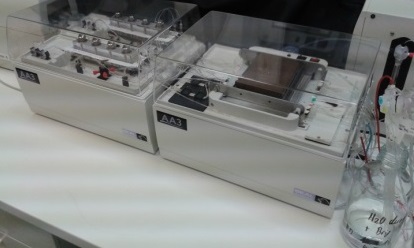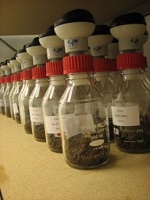- Your Product Type
- Your Study Type
- Aquatic Ecotoxicology
- Aquatic Invertebrates
- OECD 202: Daphnia sp., Acute Immobilisation Test
- OECD 211: Daphnia magna Reproduction Test
- OECD 235: Chironomus sp., Acute Immobilisation Test
- OECD 218/219: Sediment-Water Chironomid Toxicity Test Using Spiked Sediment/Spiked Water
- OECD 233: Sediment-Water Chironomid Life-Cycle Toxicity Test Using Spiked Water or Spiked Sediment
- OECD 225: Sediment-water Lumbriculus Toxicity Test Using Spiked Sediment
- OECD 242: Potamopyrgus antipodarum Reproduction Test
- OECD 243: Lymnaea stagnalis Reproduction Test
- Fish and other vertebrates
- OECD 203: Fish, Acute Toxicity Test
- OECD 215: Fish Juvenile Growth Study
- OECD 212: Fish, Short-term Toxicity Test on Embryo and Sac-fry Stages
- OECD 231: The Amphibian Metamorphosis Assay
- OECD 236: Fish Embryo Acute Toxicity Test
- OECD 210: Fish, Early-life Stage Toxicity Test
- OECD 229 Fish Short Term Reproduction Assay and OECD 230 21-day Fish Assay
- OECD 240 Medaka Extended One Generation Reproduction Test (MEOGRT)
- OECD 248: Xenopus Eleutheroembryonic Thyroid Assay
- OPPTS 850.1500: Fish Life Cycle Toxicity Test
- OÈCD 234 Fish sexual development test
- Aquatic plants
- Analytical Dose Verification
- Aquatic Invertebrates
- Chemistry
- Biodegradation Studies
- Analytical Chemistry Studies and Residues
- Physical-Chemical Properties Studies
- Storage Stability Studies
- OPPTS 830.6302, OPPTS 830.6303,and OPPTS 830.6304: Physical State, Colour and Odor at 20 °C and at 101.3 kPa
- EU A.1: Melting temperature/range
- EU A.2: Boiling temperature
- EU A.3: Relative density (liquids and solids)
- EU A.4: Vapour pressure
- EU A.5: Surface tension
- EU A.9: Flashpoint
- EU A.10: Flammability (solids)
- EU A.12: Flammability (contact with water)
- EU A.13: Pyrophoric properties of solids and liquids
- EU A.16: Relative self-ignition temperature for solids
- EU A.17: Oxidising properties
- OECD 114: Viscosity of Liquids
- Environmental Fate
- Transformation in Soil
- Transformation in Water
- Transformation in Manure
- Adsorption on Soil and Sewage Sludge
- Bioaccumulation and Bioconcentration
- Terrestrial Ecotoxicology
- Non-target Arthropods
- Non-target arthropod testing with the parasitic wasp (Aphidius rhopalosiphi)
- Non-target arthropod testing with the lacewing (Chrysoperla carnea)
- Non-target arthropod testing with the ladybird beetle (Coccinella septempunctata)
- Non-target arthropod testing with the predatory bug (Orius laevigatus)
- Non-target arthropod testing with the predatory mite (Typhlodromus pyri)
- Non-target arthropod testing with the rove beetle (Aleochara bilineata)
- Non-target arthropod testing with the carabid beetle (Poecilus cupreus)
- Non-target arthropod testing with the wolf spider (Pardosa spec.)
- Soil Organisms
- Honey Bees and other Pollinators
- OECD 213/214: Honey bees, Acute Oral and Acute Contact Toxicity Test
- OECD 245: Honey Bee (Apis Mellifera L.), Chronic Oral Toxicity Test (10-Day Feeding)
- OECD 237: Honey Bee Larval Toxicity Test, Single Exposure
- OECD 239: Honey Bee Larval Toxicity Test
- EPPO 170: Honey Bee Field Study – do plant protection products effect honey bee colonies?
- Oomen et al. 1992: Honey Bee Brood Feeding Study
- OECD 75: Honey Bee Brood Test under Semi-field Conditions in Tunnels
- OECD 246/247 Acute Oral and Contact Toxicity to the Bumblebee, Bombus terrestris L.
- Solitary Bee Acute Contact Toxicity Study in the Laboratory (Osmia sp.) Solitary Bee Acute Oral Toxicity Study in the Laboratory (Osmia sp.) (protocols for ringtests with solitary bees recommended by the non-Apis working group)
- SANTE/11956/2016 rev.9 Residue trials for MRL setting in honey
- Non-target plants
- OECD 208: Terrestrial Plant Test - Seedling Emergence and Seedling Growth Test
- OECD 227: Terrestrial Plant Test - Vegetative Vigour Test
- OCSPP 850.4100: Seedling Emergence and Seedling Growth
- OCSPP 850.4150: Vegetative Vigor
- EPPO PP 1/207(2): Efficacy evaluation of plant protection products, Effects on succeeding crops
- Field Studies
- Non-target Arthropods
- Ecological Modelling
- Quality Assurance
- Testing of Potential Endocrine Disruptors
- Aquatic Ecotoxicology
- News
- Company
- Career
- Contact
OECD 216/217: Nitrogen and Carbon Transformation Test
Soil microorganisms are very important for the breakdown and transformation of organic matter through mineralization. Long-term interference with the biochemical processes could potentially affect the nutrient cycling thus altering the functionality of the soil. The impact of chemicals on the soil microbial community needs to be assessed if products are applied to soil or if an exposure of soil is likely. For agrochemicals, the effect of two test item concentrations on nitrogen transformation is required. If non-agrochemicals are tested, a dose-response study might be necessary.
Study Design
Soil
A sandy soil according to the OECD specifications is used. The soil is freshly collected e.g. from an untreated field site near ibacon. After sampling the soil is air dried, sieved and pre-incubated in ventilated boxes at room temperature with frequently moistening.
Test concentrations
For agrochemicals and medicinal products usually two test item concentrations are tested. The test item concentrations are based on the single application field rate and up to ten times that concentration (depending on the number of applications per season) or on the predicted environmental concentration (PEC) and a multiple of it. For biocides and industrial chemicals under REACH, usually five concentrations are tested in order to receive an effect concentration (ECx).
Course of the test
The test item is applied onto soil either as a solution in water or applied onto quartz sand. Three replicates are used for the control and the test item concentrations. For nitrogen transformation studies, the soil is mixed with powdered Lucerne meal to supply the microorganisms with a source of required carbon to nitrogen ratio. As a reference item, a control is tested in parallel. After application to the soil, the samples are incubated in a controlled environmental room in the dark. Soil moisture is adjusted and maintained during the study. These conditions allow rapid microbial metabolism. Samples of the incubated soils are taken after application (day 0) and after 7, 14 and 28 days, respectively. At each sampling date the dry weight, nitrate content and / or short-term respiration is determined. The results of the nitrogen transformation (nitrate levels) and the short-term respiration measurements are statistically analyzed for comparison of the control group with the treatment groups. If, after four weeks, the results for the control sample and the test item treated samples differ for more than 25 %, the test is prolonged up to 100 days.
A test with a toxic reference substance is performed at least once a year to proof sensitivity of the test design.

Measurement of nitrogen transformation
The soil samples collected at sampling dates are extracted with a suitable extraction solvent (e.g. KCl) by shaking and centrifugation afterwards. The extracts were analysed for nitrate-N (and nitrite-N and ammonium-N if necessary) by means of Continuous Flow Analysis and comparision with known standards.

Measurement of carbon transformation
The collected soil samples are analysed for glucose induced respiration rates. An appropiate amount of glucose is mixed with the samples and incubated in closed vessels. To calculate oxygen consumption and carbon dioxide release, the pressure decrease in the reaction vessels is measured up to 24 consecutive hours.
Endpoints
The soil respiration of the treated samples and the nitrate-N content of test item treatments are compared with the untreated control. Furthermore, incremental (between two sucessive sampling dates) or cumulative (between sampling date and day 0) nitrate rates are calculated. The nitrate-N rates and nitrate content and the soil respiration of the test item treated samples should be lower than 25% compared to the control at the end of the test. The endpoints for a dose-response study are the calculated ECx values.
Guidelines and literature
- OECD-Guideline for the Testing of Chemicals, Soil Microorganisms: Nitrogen Transformation Test, Guideline 216, January 21, 2000.
- OECD-Guideline for the Testing of Chemicals, Soil Microorganisms: Carbon Transformation Test, Guideline 217, January 21, 2000.
